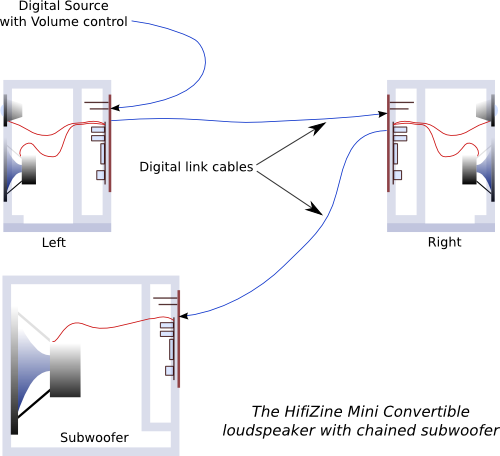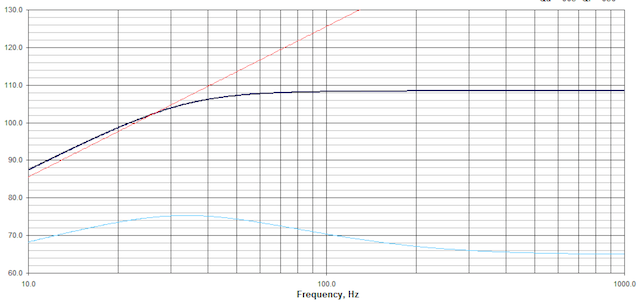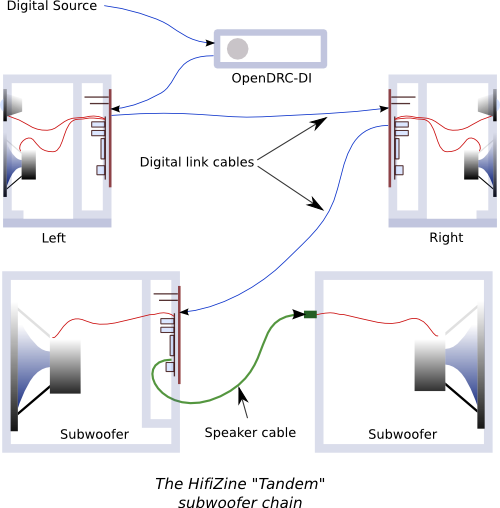The Tandem subwoofer
Updated 27 Oct 2013.
I never thought I’d get excited about a plate amp.
But, while waiting for the drivers for the Mini Convertible active speaker project, I was wondering how best to add a subwoofer to the sealed/monitor version of the speaker. After working through a couple of options, the completely obvious hit me: the PWR-ICE125 plate amp provides a buffered copy of its digital input signal, so there’s no reason that you can’t chain a subwoofer built with a third PWR-ICE125 amp, like this:

In this setup, the amp in the subwoofer is set to sum both left and right channels, and to run in BTL (bridged) mode. A couple of observations here:
- There’s no reason to stop at one subwoofer – as far as I can tell, you can chain as many more as you like. It’s not hard to envisage a distributed multi-sub system built using these, with additional subs being added whenever funds allowed or the need arose.
- The digital source needs to be volume-controlled. While each PWR-ICE125 does have a volume control, it applies only to the amp that it’s on and doesn’t affect amps further down the chain. (This is as it should be: the digital link out is a buffered copy of the input, no reclocking, sample-rate conversion, or other processing.)
What would be a good driver for this? One good-looking option is the Dayton RSS315HFA-8 12″ subwoofer driver. At the rated 250W (into 8 ohms) of the amp in BTL mode, this is its simulated output (half space, anechoic) in an 84 liter (3 cu ft) sealed box:

Maximum output is 98 dB at 20 Hz (excursion limited) and 106 dB at 40 Hz (power limited), with an f3 around 36 Hz. Why an 8 ohm driver? While the amp is rated to operate into a 4 ohm load in BTL mode, the continuous power rating into this load is much less. Personally, I just feel more comfortable with a more conservative 8 ohm driver in this situation.
So far so good. What if you wanted a smaller box? Here’s another option: use a smaller driver, but use two boxes. Eh what? Let’s look at this option: build the plate amp into one subwoofer box, and also build a second “passive” subwoofer box. Then we run the plate amp in “stereo” mode instead of BTL mode. It looks like this:

I mentioned above that the digital source has to have a volume control, but if it hasn’t, this can be done by putting a miniDSP OpenDRC-DI at the front of the chain, which I’ve shown in the above diagram. Once you have one of those in the chain, you can use it to linearize the phase of the whole system, with the aid of rePhase.
What about output levels – do we lose or gain anything? Here’s an example, a pair of Dayton RSS265HF-4, each in its own 28 liter (1 cu ft) box:
Maximum power output is 98 dB at 20 Hz, and 106 dB at 40 Hz, both power-limited. So, the same as the single 12″… f3 is about 46 Hz… but you can easily alter this with a Linkwitz transform. We have incurred the cost of two 10″ drivers now instead of a single 12″, so what did we gain?
- Each box is much smaller – 28 vs 84 litres (1 vs 3 cu ft) – and therefore likely to be easier to place.
- With two subs, we increase the number of bass sources, which can (if done carefully) help produce a smoother (pre-EQ) response.
While it certainly wouldn’t hurt if the amp had more power – say twice as much – for an extra 3 dB maximum output above around 30 Hz, this is still enough for most home systems, and likely to be suited for situations where space is at a premium. Of course, you can play numbers games like these all day, but in the end the builder has to choose what suits them best. Horses for courses, as they say… but still, this is all pretty cool.
Forgive my lack of audio knowledge, but could you explain in more detail why the 8 ohm speaker choice was better for this amp than the 4 ohm load its rated for? Is it something to do with the RMS of the amp? I’m on the fence about using this amp for a future diy sub build.
Thanks.
Hi Andrew, what driver are you thinking of using?
Anything good. 🙂 I was going to initially use that same driver except in a 4 ohm load in a home theater setup. But then your choice of 8 ohm confused me. Would the 8 ohm speaker with this amp be enough for a 19x19x8 room? I know you can never have enough but I’m just looking for a well balanced setup with some “presence”. Thanks for asking!
Hi Andrew, just to be clear I reference two different drivers above. In the BTL mode with a single driver it’s an 8 ohm 12″ driver. In “tandem” mode with two drivers it’s a pair of 4 ohm 10″ drivers. The reason I suggested using an 8 ohm driver in the BTL configuration is because of the continuous power rating of the amp module in that configuration – this information is in the ASX2 datasheet and also in the PWR_ICE125 amp user manual. In BTL mode, each channel is effectively seeing half the load impedance, so if using a 4 ohm driver each channel is effectively driving into 2 ohms. Under these conditions the continuous power rating is substantially less than the short term power output. It seems to be fairly common these days to have a continuous power rating less than the short term rating, as it allows for less heatsinking, even with Class D….
So, the conservative choice (for someone like me who started building kit amps when we used to calculate the heatsinks’ thermal resistance for continuous full power output…) would be an 8 ohm driver. However, does it really matter? I don’t know. It just depends on how you use it. Also bear in mind that the difference between 250 and 450 W is less than 3 dB in output. And the final data point, with 250W the RSS315HFA-8 in 3 cuft reaches Xmax about 27 Hz, and at 38 Hz with 450W. So below those frequencies you are excursion limited not power limited. Somewhat paradoxically, I suppose I might use the 4 ohm driver for music applications and the 8 ohm driver for HT applications (and look to add a second unit when funds allowed). But that’s simply a personal choice.
I’ve started building some subs and do have some 4 ohm 12″ drivers that are a bit similar to the RSS315HF, so perhaps I’ll make one with a slot for the amp and try it.